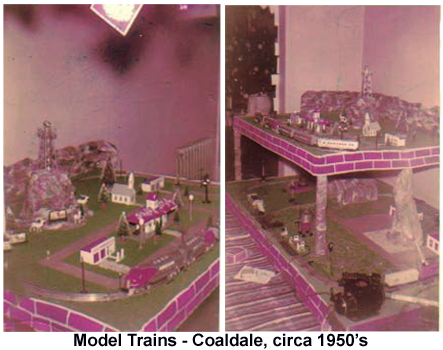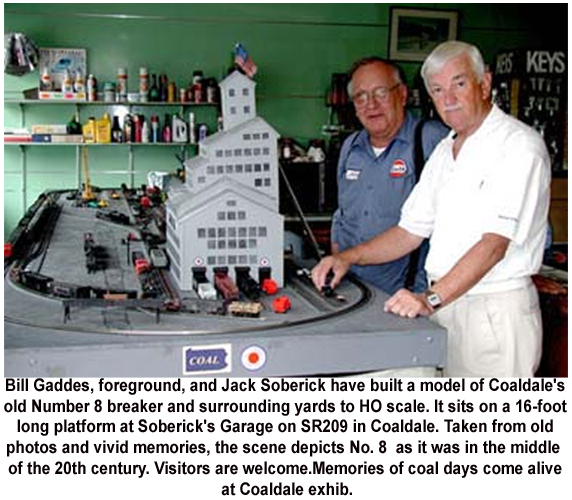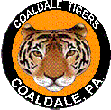|
Memories of coal days come alive at Coaldale exhibit
By AL SWORD.(2002)
Railroad enthusiasts, coal-region fans and history buffs in general will all enjoy the HO-scaled model of the Number 8 breaker and surrounding coal yards created by Bill Gaddes and Jack Soberick in Soberick's garage along SR209 in Coaldale.
The model, just inside the front door, was Soberick's idea. Gaddes, a longtime friend and fellow Lionel Train collector, was quick to join in. The project began in January with an idea of having a display for this year's 175th anniversary celebration in Coaldale.
It's "sort of" finished now and many who returned for Coaldale's Community Day celebration had a chance to see it.
"It will never really be finished," Soberick said laughing. Details could be added to infinity as the work-in-progress takes shape from old photographs and Soberick's vivid childhood memories.
Soberick's garage sits along the old entrance to No. 8. He grew up in the apartment upstairs with the mile-long grounds of No. 8 serving as his backyard and playground.
Bill Gaddes was born in Nesquehoning and grew up in Coaldale. They are both children of the 40s and both were introduced to Lionel Trains as youths.
 Bill worked in a paint store in Tamaqua while attending Coaldale High. The store sold train kits, which he assembled as part of his duties. Bill worked in a paint store in Tamaqua while attending Coaldale High. The store sold train kits, which he assembled as part of his duties.
Soberick's garage was a Lionel Train dealer, and Jack says he got his first set from his father George about 1946. In those days Soberick's was something of a general store, selling everything from gasoline, to bread and milk, to major appliances, and - of course - Lionel Trains.
Bill constructed the model of No. 8. Jack did much of the assembly of the surrounding coal yard from memory. Although everything is built to the HO Railroad scale of 1 to 87, the yard itself is what modelers call "compressed." That means the huge yards are reduced and configured to a 16 foot-long rectangle.
Bill calculated that if the yards were built to a realistic HO scale the display would have to be more than 60 feet long.
Timmy Vincent of Coaldale contributed additional rail cars and Harry Castle of Summit Hill provided additional track for the display.
Sound bites
The most fascinating thing about seeing the display is listening to Bill and Jack talk about the Number eight shaft and breaker and the Coaldale they remember from their youth in the middle of the last century.
It was a time when coal was still king and everybody worked in or around the mines or on the railroads that served His Majesty.
As Bill and Jack exchanged memories, the idea of an interview vanished under a breaking wave of Coaldale trivia mined from their memories.
Bill's uncles, in fact everybody on his mother's side, worked for the railroad and Bill got to ride in the caboose down to Jersey City where they would stay overnight and return the next day.
The "Loki" that hauled the rock from the breaker to the rock banks that now line the northern edge of the borough, chugged up the slope all day, every day. The sound carried throughout the borough and the only time you noticed it, Jack said, was when it stopped.
Bill: "As long as the Loki was running, you knew things were good," Bill recalled. (Loki was coal region slang for locomotive.)
Bill: "In 1931, coal cost $1.31 a ton and a miner made about $5 a day, which was pretty good at that time."
Jack: "Coal was $2.50 a ton in 1954, $4 if you had Fredericks deliver it."
"Bill: "There's about five-billions tons of coal remaining from the Panther Valley to MaryD."
Jack: "The No. 8 shaft was 1,227 feet deep, the deepest in the Panther Valley.
"Bill: "There were 7,000 miners in the Panther Valley and Tamaqua when the mines were going. Coaldale had 45 bars. A bar was the first two-rooms of a home. The wife ran the bar and took in single-men as boarders. The husband and boarders worked in the mines and were the primary customers in the bar. That and a few other regulars were enough to make it profitable."
Anybody can see the display weekdays at Soberick's between about 10 a.m. and 3 p.m.
|


 Bill worked in a paint store in Tamaqua while attending Coaldale High. The store sold train kits, which he assembled as part of his duties.
Bill worked in a paint store in Tamaqua while attending Coaldale High. The store sold train kits, which he assembled as part of his duties.